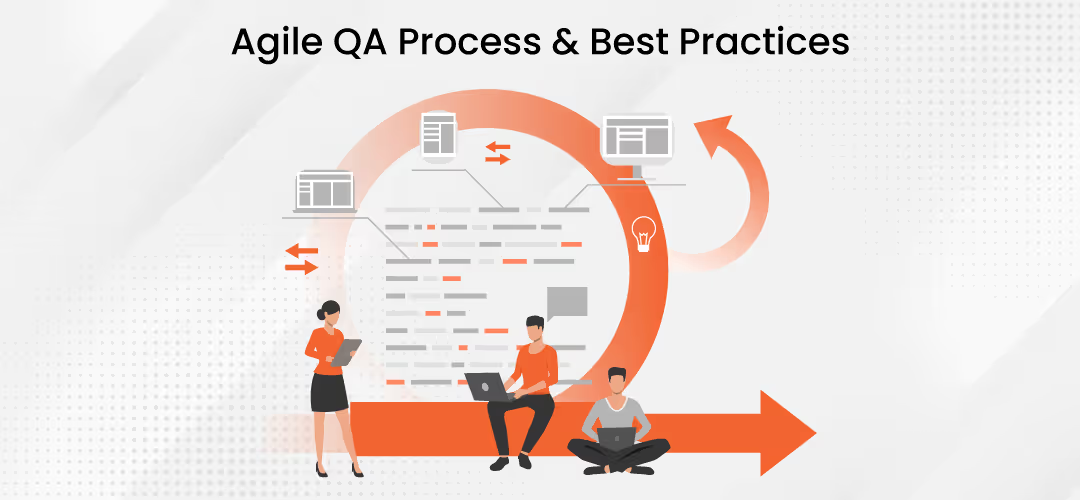
Quality Assurance (QA) has always been a critical component of software development progress. There can't be a software development team without at least one Quality Assurance analyst (who does a critical analysis and testing of the application).
In addition, a QA has a more extensive role in agile development than traditional development methodologies. Let's look at how a QA may help the board with its Agile duty and how that function can be insecure.
What is Agile?
The Agile technique is a project management approach that breaks a project into stages. It necessitates constant stakeholder contact and development at each phase. Teams go through a cycle of planning, executing, and evaluating once the project begins.
Collaboration between team members and project stakeholders is critical. Agile also aids in reducing technical debt, increasing customer happiness, and producing a higher-quality product in less time.
Agile QA process
Agile testing adheres to Agile development's best practices. For example, agile development is a step-by-step design approach performed sequentially.
The agile QA process implements at the beginning of the Software Development Life Cycle. We've covered you from the first design meeting to the final round of testing and stabilizing the application. Testing is done in several sprint iterations and close collaboration with the developers until the project completes.
Tests are prioritized in the same way as the user stories are. Testers aim to finish as many tests as feasible in each cycle. Using automated testing technologies can assist testers in completing more of the testing backlog.
Most businesses have switched from a waterfall to an agile development process to ensure faster and smooth release of the software into the market rather than causing the project to derail entirely. Lesson’s learned from the previous projects can be used by the quality assurance (QA) team to analyze and improve the process for future initiatives.

Early Test and Early Feedback
In Agile development, testing needs to happen early and often. So, instead of waiting for development to be finished before testing begins. As new features are available, the testing will continue. Early and constantly testing will allow the QA (Quality Assurance) engineers to find errors/bugs faster.
Thereby providing early feedback to the developers to fix the error quicker, ensuring and lowering the risk of finding a critical issue/bug at the end of the testing and release cycle.
Agile Test Plan
An Agile Test Plan is critical because it allows Quality Assurance (QA) team to keep all high-level scenarios, business requirements, and estimates in one location. In addition, QA Analysts or Agile Testers will fill up an Agile Test Plan during the sprint planning event. Therefore, an Agile Test Plan with an adequate and clear structure should incorporate business inputs and QA tasks.
Agile Test Plans usually begin with an introduction, even a project overview containing general information about the sprint's testing procedure. This section of the text covers the following topics:
- Introduction
- QA environment
- Testing scope
- Testing process
- Risks and dependencies
- Entry and Exit criteria

Agile Test Methodology
In Agile development, tests come first. You must define the approval criteria while creating a user narrative. It makes no difference if we use Scrum, XP, or Kanban as an Agile test methodology. Agile testing methodologies often include the following.
- Test-Driven Development (TDD)
TDD (test-driven development) begins with tests. This development method starts with a discussion of what we want to test, followed by the design of a user story. As a result, we will begin by developing a unit test, followed by a user story. Finally, we build code till it passes the unit test. The most common usages of TDD are unit and component tests performed with automated testing tools.
- Acceptance Test-Driven Development (ATDD)
ATDD stands for acceptance test-driven development. However, ATDD begins with user feedback on its functioning. This type of project starts with discussing how the product will use. As a result, you create a user acceptability test (UAT). Then, the code is updated till it passes the test. ATDD is frequently used to conduct acceptance testing. It ensures that the product performs as expected by users.
- Behavior-Driven Development (BDD)
TDD and ATDD are frequently the sources of behavior-driven development. The objective of evolution in behavior-driven links to a business outcome. So you'll have a user story — but it needs to explain why this feature formed in business terms. Tests include user stories as scenarios or requirements in BDD. BDD is used to conduct acceptance testing. It verifies that the product's characteristics are necessary for the desired business outcome.
- Exploratory Testing
Exploratory testing is a type of testing that allows testers to go with their instincts rather than following a predetermined path, usually accomplished by hand. Instead, you record your actions and store them as a test. And as you proceed, you figure out precisely what you're testing. This type of testing can reveal a product's hidden risks. These are the bugs missed during TDD functional testing.
- Session-Based Testing
Session-based testing resembles exploratory testing, which is more structured. You start with a task in mind rather than figuring out what you're testing as you go. Session-based testing can uncover issues that may conceal within a project.
Agile Best Practices
The three pillars of Agile software development are flexibility, sustainability, and quality. These are some of the best practices for efficient and productive engagement on Agile teams to gain a deeper grasp of Agile methodologies.
- Customer Satisfaction through Customer Collaboration
When this comes to Agile, the first and most important goal is to provide Customer Satisfaction. In typical development techniques, customers are involved in the beginning when demands are established and at the end when the project got finished, which leads to consumer dissatisfaction.
Because feedback is essential for creating a great product, the Agile approach involves the customer throughout the process, communicating options, clarifying expectations, and collaborating on changes. The team's and the customer's constant contact fosters creativity and improves customer satisfaction.
- Teamwork
Agile involves a group of people working together to produce successful projects. Increased teamwork through coordination, good communication, mutual support, and a contributive perspective are critical for an agile team. They are empowered to make bold decisions that result in cutting-edge products when they work together.
- Motivated Individuals
Creativity will guide motivation. It is a critical aspect of any business. Motivated people have a purpose in mind when they go to work every day, and they are people who are focused and want to get better at what they do. Agile teams are motivated gifts to any firm and can keep up with the fast pace.
- Organizational Team
Self-organizing teams that work in symmetry guide agile software development. They are skilled in deciding how they complete the task and who will be responsible for what. They break down their projects into smaller iterations and finish them in a sprint.

Benefits of QA in Agile
- Faster and better test results are produced when the team of developers, architects, testers, and product managers collaborate closely with more excellent communication and collaboration across the entire life cycle. Agile testing is easier and faster due to its unstructured nature, as it does not require an immense amount of documentation.
- The incremental and iterative models cropped the time it takes to specify test requirements and validate results. It will ensure that project release cycles are completed on schedule and without error.
- In an agile environment, centralizing the software testing tools and resources optimizes resource utilization and lowers the cost of software purchase, setup, and maintenance. In addition, it puts a greater emphasis on the product's overall quality. Bug fixing at each iteration of development help's to keep the project's overall cost down and ensure that the product or application will release on schedule and free of issues.
- One of the most important aspects of agile is the ability to solve problems and find errors early. It is possible because testers and developers collaborate in a close-knit environment that allows them to communicate and receive immediate feedback, allowing for bugs and error fixes while the code is still in development.
- Agile testing identifies outcomes in shorter cycles and provides visibility into the project's quality level. It will allow the team to take necessary corrective action to improve product quality at the appropriate time. It also helps businesses improve application quality and performance by preventing significant faults in applications and products.
- As it becomes more expensive to resolve critical problems as a product feature progress through the development cycle, involving QA as early as feasible allows these issues to be addressed quickly and shorten the impact.
- In agile, the role of QA is not only limited to testing but also constantly supporting development. The notion is that developers and testers must work together to deliver code and complete the project according to the client's specifications. In addition, QA aids in the earlier detection of flaws and potential defects found in the software during development.
Conclusion
Iterative software development is the core of agile techniques. Each iteration culminates in the production of a fully functional module. An iteration of code or development should not take longer than the sprint timeline, which is two weeks.
Agile methodologies encourage engineers to participate in testing rather than having a unique quality assurance team. Agile procedures the high desirable in the quickly changing software life cycle due to new techniques and concepts that enable a team to produce a product in a short amount of time.
Unlock Agile Excellence with Fission Labs' QA Expertise
Are you striving for Agile perfection in your software development journey? Look no further. At Fission Labs, we understand the paramount importance of a robust Agile QA process and can help you navigate the intricacies of Agile testing with finesse.
Our team of seasoned QA professionals possesses a wealth of experience in Agile methodologies, and we're ready to empower your software development projects. By leveraging best practices and cutting-edge tools, we ensure that your software is not just functional but impeccable.
Why Choose Fission Labs for Agile QA?
- Expert Guidance: Our Agile QA experts will tailor a comprehensive strategy that aligns seamlessly with your Agile development cycle. We provide guidance from the project's inception to completion.
- Efficiency and Speed: Experience accelerated development cycles with our Agile QA processes. We enable quicker releases without compromising on quality, giving you a competitive edge in the market.
- Continuous Improvement: We believe in the Agile principle of continuous improvement. Our team conducts retrospectives to identify areas for enhancement and refine our QA process continuously.
- Automation Excellence: Harness the power of automation with our expertise. We implement automation testing frameworks that optimize test coverage and deliver results swiftly.
- Collaborative Testing: We foster collaboration between development and QA teams, ensuring that testing is an integral part of the development process, not a bottleneck.
Don't miss out on the opportunity to achieve Agile excellence with our tailored QA solutions. Contact Us today to schedule a consultation with our Agile QA experts. Together, we'll embark on a journey to streamline your QA process, accelerate software delivery, and elevate your product quality.
Get in touch with Fission Labs now, and let's transform your Agile QA process into a competitive advantage!
Contact Us | Learn More About Our QA Services
Content Credit: Satya Deepika Tellkula & Devi Thushara Pendyala



